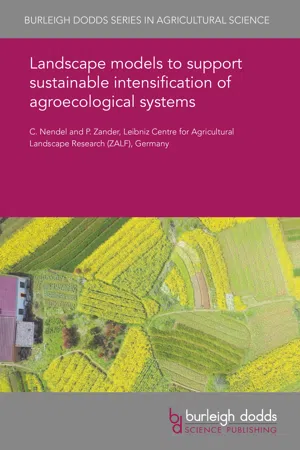
Landscape models to support sustainable intensification of agroecological systems
- English
- PDF
- Available on iOS & Android
Landscape models to support sustainable intensification of agroecological systems
About this book
Intensification of agriculture to meet the growing demand of food and renewable resources is contrasted with a decrease in species diversity, pollution in water bodies and a decline in freshwater resources. To protect our resources, the natural functioning of ecosystems and the diversity of landscapes, agricultural land use must reduce its resource use and its impact on biodiversity and ecosystems. Addressing both challenges simultaneously requires a perspective that takes a more detailed look into the heterogeneity of climate and soils and their role in agroecosystem functioning, the interactions between flora and fauna, the interdependencies with the green infrastructure at landscape scale and the role of humans and how they organise themselves in this system. In this chapter the authors reflect on the different social, economic and natural features of agricultural landscapes that govern important processes in agro-ecosystems and discuss current approaches for modelling ecosystem services using a landscape approach.
Frequently asked questions
- Essential is ideal for learners and professionals who enjoy exploring a wide range of subjects. Access the Essential Library with 800,000+ trusted titles and best-sellers across business, personal growth, and the humanities. Includes unlimited reading time and Standard Read Aloud voice.
- Complete: Perfect for advanced learners and researchers needing full, unrestricted access. Unlock 1.4M+ books across hundreds of subjects, including academic and specialized titles. The Complete Plan also includes advanced features like Premium Read Aloud and Research Assistant.
Please note we cannot support devices running on iOS 13 and Android 7 or earlier. Learn more about using the app.
Information
Table of contents
- 1 Introduction
- 2 Society and ecosystem services
- 3 Bio-economic and social interaction models
- 4 Agroecological models in the landscape context
- 5 Biodiversity
- 6 Case study
- 7 Conclusion
- 8 Future trends
- 9 Where to look for further information
- 10 References